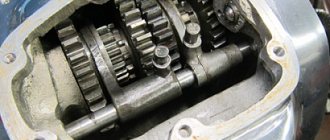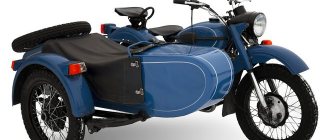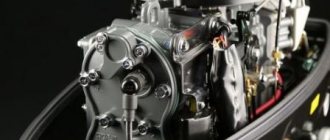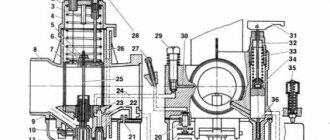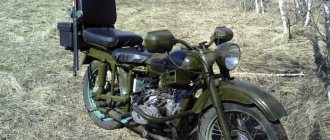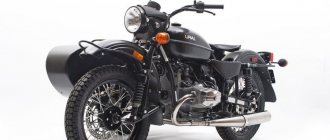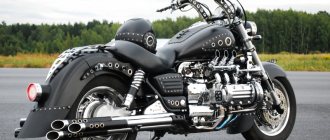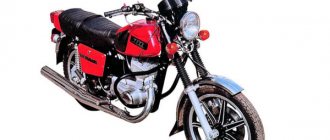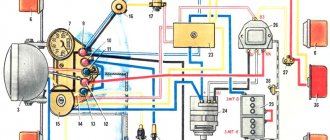Perhaps the most recognizable among domestic motorcycles, of course, is the Ural. In the economically difficult times of the Soviet Union, for families who could not afford to have a car, which was a luxury, they chose the Ural motorcycle. And for good reason, because its 4-stroke engine is the easiest to repair and unpretentious to maintain. Nowadays, Ural motorcycle tuning is developing among customizers who give this model a second life. Many especially loved the sound of this boxer engine. Well, now we’ll find out how to do tuning of a Ural motorcycle with our own hands.
There are a great many areas of tuning the Ural motorcycle. From high-quality restoration and revival of the legend, to incredible transformation into a cool chopper. It’s important to immediately understand what you want, decide on a style, and not put everything on the motorcycle. Whether it is converting a sport bike or a chopper, first of all you need to take care of the technical condition of the engine and improve its characteristics. After all, this is the main part of the motorcycle. Most often, problems with original carburetors are annoying, which are not able to ensure high-quality synchronous operation of the cylinders, thereby even reducing the engine's life. They must be immediately replaced with imported carburetors. The second problem is ignition. The cam-type mechanism often fails and the contacts burn out. Here it is simply necessary to replace it with a contactless ignition system with a Hall sensor. Loss of compression in the cylinders is also an eternal disease that can be solved by replacing the rings with modern automobile ones with a set of oil scraper rings, as well as cleaning the valves from carbon deposits and grinding them in. Check the condition of the flywheel pins, the holes of the intermediate discs and the thickness of the clutch discs. Often the fingers are worn out, the disc holes are broken, and the clutch is worn out. To modernize this unit, you can install reinforced springs, replace the slider bearing with a large number of balls, or even better, a needle bearing. Don't forget to lighten the flywheel by 1-1.5 kg. This will give a noticeable improvement in speed gain. Installing an aluminum pan on a Ural motorcycle will also be no less useful.
You can read more about Ural motorcycle engine tuning: detailed information here.
Let's move on to the external tuning of the Urals. Now that the motor is in proper shape and condition, decide on the direction. Let's look at examples of model tuning from simple to complex.
Cafe Racer
One of the most popular areas of tuning a Ural motorcycle. The main reason for this is the ease of changing the appearance of the motorcycle, by removing unnecessary parts and replacing standard ones with more elegant ones, and most importantly, lighter ones. To do this, the tail of the motorcycle is slightly reworked for a new seat, road tires are installed, and, if desired, lighter rims, but always on spokes - this is a tribute to style.
Tuning a Ural motorcycle that won’t interfere with the classics - why a motorcycle?
Time does not stand still, technology is constantly evolving, new, more modern opportunities for people appear.
But there is a technique that is not subject to temporary changes: the Ural motorcycle. The pride of the Irbit plant is known to all domestic motorcyclists, and Ural tuning is the real pride of Russia. Tuned Ural motorcycle
Over the past few years, production has become more modernized, most of the work is done by machines, and Ural tuning has improved significantly. Today, the plant is receiving foreign investment and, together with international specialists, domestic craftsmen are working to improve the model range. Motorcycle tuning and modernization comes to the fore in the company. The successful start of the new generation Ural model M70 Sidecar is evidenced by the tuning of this Ural motorcycle made in accordance with all international requirements.
Tuned Ural motorcycle
According to a sociological survey, the most popular motorcycle of the new millennium is the Ural motorcycle. Tuning it can characterize the owner and depends directly on his preferences. At the factory, most models are equipped with a stroller, which is designed to transport passengers. Tuning a Ural with your own hands can be done regardless of whether the vehicle is equipped with a stroller or not. If it is, you can tune the Ural stroller. There are many useful recommendations on this matter on the Internet; just enter in one of the search engines: “Ural tuning video or Ural motorcycle tuning video.”
If you are not sure that you are ready to carry out these steps yourself, then let's get started. In order to tune a Ural motorcycle, photos of which are in every phone, you need to acquire free time and special knowledge in the automotive field.
To do this, you need to: upgrade or decorate the wheels, install new rims, decorate the sides with special colorful ribbons or chrome inserts.
Sidecar wheel on a motorcycle Ural Wheel tuning in the Urals
You can also do tuning yourself. It is better to buy spare parts for the Urals from an official representative. Tuning can be divided into those that change external and internal characteristics. Internally, improving the Urals helps improve its performance. In addition, tuning the Ural engine can significantly extend the life of the motorcycle. With the chassis, it is recommended to simultaneously improve the suspension, replace the brake and engine fluid, and if necessary, you can replace the entire system. Finally, the exhaust pipe may need to be replaced. External tuning improves the appearance of vehicles. New parts and devices are added to it, external components and blocks are changed, and painting is carried out. After it, the surfaces are given smoothness and shine, thanks to special polishing devices, while the internal filling of the machine is not changed. Before you take your motorcycle into the garage for repairs, you need to study the information on Ural motorcycle tuning. Photos can be found both in specialized magazines and on forums of Ural owners. First, they remodel the rear of the motorcycle. Tuning the engine of a Ural motorcycle is not worth doing.
Divide the work into several stages:
- Remove the seatpost.
- Weld the bent pipes. Their diameter should not be more than 0.28 cm.
- Install rear shock absorbers. Pass it at an angle, as a result the suspension will become softer.
After you have installed the rear wheel, check the rubber part. It functions properly when there is no distortion and the engine is horizontal. Next, pay attention to the running boards. They need to be set forward, thus increasing comfort while driving. As a result, the frame will lengthen by 100 mm. What to do with the tank?
- Use an angle grinder to remove the glove compartment.
- Do the same work with the tunnel and neck.
- Cut off the tank and all unnecessary parts.
Conducts seat tuning:
- Cut the base from a special material; the thickness of the steel should not be more than 0.2 cm.
- Use solid metal to cut out the clutch, brake and handle.
- Be sure to point the muffler to the correct side.
Important. In second place in popularity after the motorcycle is the Ural truck. Tuning it should be carried out according to the same principle. Tuning spare parts for the Urals. Engine. The engine is the basis of any transport; it determines the characteristics of the technical device of the car. Deep tuning should start with the engine. On Ural motorcycles it can be forced. Important! The engine can be boosted only if all faults have been eliminated. There are different ways to give the engine extra performance, here are some of them:
- It is necessary to reduce the friction force at the inlet. There should be nothing in the system that prevents free suction. Remove all air filters and obstructions.
- Change the device in which carburation occurs.
Motor modernization:
- Raise the outlet window by 200 mm. To do this, remove all unnecessary parts using a file.
- Reduce the diameter of the rounds and use a small file to round off the sharp edges. If you do everything correctly, the motor's performance will double.
Bobber
An equally popular direction for tuning a Ural motorcycle in the “bobber” style. There can no longer be any shock absorbers at the rear, because style dictates the rules. Main features: the so-called “cracker” frame, which is obtained by changing its rear part. The second main feature of a model in this style is a miniature tank, which should be enough for a train of 100 kilometers. And of course, a miniature saddle and a high horned handlebar.
Grandfather's gift: a 1981 Ural motorcycle with only 5 km on the clock
Here is a Ural M-67-36 manufactured in 1981 - my grandfather’s favorite toy, which none of the family knew about. Detective? No! Life, after all, is much richer than anything a writer can dream up.
Once in the 21st century, a motorcycle was discovered in one of the garages in the city of Tomsk. For 34 years, the heavy bike had never left the garage, so its appearance shocked the household, who discovered this handsome man in his grandfather’s garage.
A completely new conqueror of Soviet roads, one of the few models of equipment that managed to get from point to point along the paths of that time. Only one dog knows how many of these horses helped their owners from 1976 to 1983, when the Ural was produced at the Irbit Motorcycle Plant. In Soviet times, these bikes were especially valued for their good cross-country ability, unpretentiousness and reliability.
But our hero didn’t wear out a wheel or burn a liter of gasoline while he was standing in the garage. Brand new, as if from an assembly line! Actually, that’s how it is: the mileage is 5 km, which was adjusted at the factory during calibration. The tank is absolutely dry, the engine is perfectly virgin.
Last year they gave 50 thousand rubles for this iron horse. And here it could not have happened without a detective: the traffic police did not register the car according to the documentation from 1981. But our man will always find a way out: a similar but worn-out brother was promptly purchased and became the donor of the license plate and documents.
It turned out that except for the carburetors and ignition system, everything in the found “Ural” was in perfect order. New carburetors to replace the oxidized ones and electronic ignition breathed new strength into the iron horse.
“Ural” M-67-36 is a heavy motorcycle from Soviet times, a reliable machine that has earned respect through honest work. It was sold only with a sidecar and was a “family car” for many Soviet citizens. There was also a version with a drive to the sidecar wheel, but it was considered a completely unattainable shortage.
The engine of the machine is two-cylinder, four-stroke. Volume – 649 cubic meters, power – 36 horses. Accelerates to 105 km/h. Runs on 72-80 gasoline, consumes 8 liters per 100 km. The tank holds 19 liters. The gearbox is designed for 4 steps, a dry-type double-disc clutch is available. Weight - 330 kilograms, lifts 260 kg. Electrical equipment is designed for 12 volts. The front fork is telescopic, the reverse suspension is lever.
The history of each “time capsule” is unique in its own way, and therefore fascinating. Recently, another incredible discovery occurred - a new Mercedes-Benz E-class W123 was found in an old garage, mothballed 30 years ago , and now ready to serve its new owners faithfully for another 30-40 years.
Sport
This is a rather unusual and not common type of tuning of a Ural motorcycle, but it still takes place. For sharp control of such a motorcycle, you need a sports fork and powerful disc brakes. Sports tires provide minimal friction with the road surface and are slightly wider for confident grip in corners and at high speed. The streamlined gas tank will have to be picked up from another sports motorcycle, and the rear part will have to be “lifted” higher to give the motorcycle an aggressive appearance. You can make mufflers in the form of cans yourself from thin-walled stainless steel, then fill the walls of the mufflers with mineral or basalt wool, which perfectly absorbs high frequencies, the exhaust will remain direct-flow, and the exhaust will become “juicy”. If desired, you can convert the pendulum to one mono shock absorber, which is a definite plus in terms of appearance.
Sports motorcycle Ural M-52S
The sports M-52 C class up to 500 cm cubed is created on the basis of the M-52 and is intended for road racing. The M-52 C is available in two versions: as a single vehicle and with a sidecar. The M-52 C engine has increased power compared to the M-52. This was achieved through the selection of more favorable valve timing, the use of a special carburetor, a more advanced exhaust system, and an increase in the compression ratio.
In addition, the M-52C engine has tulip-shaped valves, which significantly reduces hydraulic losses during intake and improves cylinder filling. For the same purpose, the intake and exhaust channels in the cylinder heads are carefully polished. The compression ratio is increased to 9.0 by using dished pistons.
To increase cooling capacity, the engine cylinders have aluminum fins. To ensure accurate valve timing, all parts of the gas distribution mechanism are made as light as possible. The rods are made of duralumin. The capacity of the engine oil sump has been increased to 2.6 liters due to the installation of a deeper sump. For better oil cooling, the pan is made of aluminum alloy and has cooling fins.
Ignition is carried out from an M-90 magneto, which is installed. on the rear of the front flange of the crankcase and is driven by a camshaft in the form of a pair of gears with a gear ratio of 1:1. The magneto shaft is connected through a claw coupling to the driven gear shaft, which rotates on two ball bearings.
The engine operating mode is monitored by speed using a tachometer.
The M-52S engine is equipped with two RIM K-99 carburetors, which are able to provide maximum engine power. The metering needle and air corrector in K-99 carburetors are located not in the inlet pipe, but in special bosses of the housing, which improves the filling of the cylinders.
The K-99 carburetor has an accelerator pump designed to increase engine response. An air supply nozzle is installed on the carburetor inlet pipe instead of an air cleaner. To better clean the cylinders from exhaust gases, megaphones are installed on the engine exhaust pipes instead of mufflers.
Clutch M-52 C has reinforced pressure springs compared to M-52. The gearbox is four-speed. The double-armed gear shift pedal is connected to the selector mechanism plate by a rod.
Due to specific features, the first gear is engaged by pressing the rear shoulder of the pedal, and subsequent gears by pressing the front shoulder.
The reverse gear is designed in such a way that its gear ratio can be changed (if this is necessary for racing conditions and is permissible in terms of engine power). Changing the gear ratio is possible due to the appropriate selection of gears.
The motorcycle comes with three pairs of replaceable gears.
Since the M-52 C is used mainly only on roads with improved surfaces, some changes have been made to the suspension design. The travel of the front fork and rear suspension is less than that of a road bike. In this regard, individual suspension parts have been modified both in size and design. The control mechanisms of the M-52 C do not have any significant differences compared to the M-52.
The steering wheel can be installed in a conventional design or made of two halves, each of which is secured to the fixed pipe of the front fork using a pinch bolt. The gasoline tank is made in one piece with a semi-fairing that covers the upper part of the front fork. The saddle has a back stop that prevents the rider from slipping onto the rear pad.
The M-52 C stroller is as lightweight as possible and is adapted for comfortable work for a wheelchair user. It is a small open platform mounted on a tubular frame, with a protective wind shield and a wheel fender. The wind shield has a viewing window covered with organic glass. The window serves to allow the wheelchair user to observe the road on straight sections of traffic. The stroller wheel does not have suspension. A wide footrest for the wheelchair user is attached near the left rear suspension of the motorcycle, on which he stands when turning left.
Similar articles:
- Sports motorcycles Ural M-52 K and M-61 K
- Motorcycle Ural Yamal
Chopper
And finally, perhaps the most interesting and complex type is: tuning a Ural motorcycle with your own hands in the “Chopper” style. First of all, this is the most expensive modification of the Urals, both in terms of time and money. A simple and insignificant re-welding of the frame is no longer enough. You will need to make a new frame almost from scratch. Water pipes with a diameter of 32mm and a wall thickness of 3mm are quite suitable for this. A wide rear wheel is a distinctive feature of all choppers. Therefore, you should choose rear tires from 150mm or more. Of course, you need a beautiful exhaust system, which is one of the main attributes of such tuning of a Ural motorcycle. The driver's seating position is feet first. To do this, it will be necessary to make stems for the legs and move the motorcycle controls forward. The wide steering wheel not only makes it easier to control, but also looks beautiful. And of course, the abundance of chrome parts such as:
- mirrors
- mufflers
- valve covers
- fork
- headlight and other small parts
We looked at the main directions of tuning the Ural motorcycle. Here, as they say, it depends on taste and color, everyone chooses their own and according to their capabilities. In any case, such a transformation of the motorcycle will not leave passers-by indifferent, and most importantly, it will bring a lot of pleasure from owning such equipment.
MY MOTORCYCLE
Urals - these motorcycles will roam the expanses of our homeland for a long time. By the way, in the USA, new Urals models are quite popular and in demand. And it won’t be long before their place is taken by a new generation of equipment, some who don’t have enough money, some who love them very much, etc. This article is so that you know what to look for when buying a motorcycle, regardless of whether it is new or not.
So the long-awaited “Ural” stands in front of its happy owner: long-time dreams of a new motorcycle have come true. The battery is charged and connected, gasoline is poured into the tank. The motorcyclist turns the ignition key, pumps gasoline into the carburetors, confidently presses the growl of the starting mechanism - the engine starts immediately. But what is this... An unpleasant screeching sound suddenly appears and grows threateningly in the front part. “Everything is clear - a factory defect,” concludes an inexperienced motorist. In fact, the reason lies in your own inexperience or outright negligence when handling a motorcycle. Therefore, let us dwell in more detail on those “pitfalls” that await new motorcyclists.
The malfunction that we took as an example is one of the most common and has the specific name “breather stuck.” Rotating in the central hole of the timing gear cover, the breather connects the engine crankcase to the atmosphere when the pistons move to BDC and, conversely, isolates it from the atmosphere when the pistons move and top dead center. The gap between the rotating breather and the cover is very small. When the engine is running, oil mist forms in the crankcase, which lubricates the breather. However, during long-term storage of the motorcycle, as well as during long periods of non-use, oil flows from the gap into the crankcase. When traveling short distances, the engine oil does not have time to warm up properly, and oil mist does not form. Consequently, the breather in this case is not lubricated or is poorly lubricated. After starting the engine, it “rubs” dry in the hole of the cover, and the aluminum from which the cover is made envelops the breather. As a result, serious engine repairs will then be required. Meanwhile, it is very easy to avoid this. Before starting an engine that has not been running for a long time, you need to use a rubber tube with a bulb to inject a little oil used to lubricate the engine into the breather channel - that’s all.
Especially do not neglect this simple operation in winter, when ice may form on the dry surfaces of the breather and cap from the water that condensed here when the engine cooled. If we started talking about malfunctions with “sticking,” then let’s talk about another common problem: “piston sticking.” In general, any “sticking” is a direct consequence of overheating. The most likely cause of overheating of the cylinders is their non-synchronization. When the throttle valves of the right and left carburetors are raised non-simultaneously (non-synchronously), the entire load falls on one of the cylinders (working ahead) instead of being evenly distributed between them. Naturally, a cylinder that “takes the breath for two” quickly overheats. Therefore, it is important not only to properly adjust the carburetors individually, but also to take care of the simultaneous raising of their throttles. The process of adjusting carburetors for synchronized operation is described in sufficient detail in the instructions for the motorcycle, so it is hardly worth repeating. At least in this material.
Practice shows that most often “sticking” of the pistons occurs after the motorcycle has been run in and the throttle lift limiters in the carburetors have been removed. Of course, one can understand the owner’s desire to find out how much his Ural will now “squeeze out”. But before you unscrew the throttle knob, remember that the possible repair of the cylinder-piston group after such an experiment is far from simple and not cheap. Even when using new motorcycles, prolonged riding at engine speeds close to maximum is undesirable. It is important to be able to recognize overheating in time. When overheating occurs, a sharp metallic knock appears in the left cylinder. The right cylinder is cooled better due to the reflection of the oncoming air flow from the side panel of the stroller, so the knocking in it appears later. When the ignition is set too early, a knock appears in both cylinders simultaneously and, as a rule, when the throttles are opened sharply. Other causes of engine overheating: improper carburetor adjustment; ignition too late; illiterate installation of wind shields for the legs, covering not only the last but also the cylinders.
Finishing the conversation about “sticking”, we remind you that good lubrication of rubbing parts is the key to their long, trouble-free operation. Therefore, never start driving with a cold engine. Let it run for at least 20...40 seconds at low speed. A normally adjusted, warmed-up engine should maintain a stable idle speed. In the cold season, drive the first 3-5 kilometers at a speed of 30-40 km/h, trying not to overload the engine. The gas distribution mechanism is that part of the engine that, as practice shows, novice motorists forget to monitor.
Next we will talk about the thermal gap in the valve actuator. If there are no gaps, the valves do not close tightly, which leads to a decrease in compression in the cylinders and, consequently, a drop in engine power. In addition, through the slightly open exhaust valve, the exhaust system communicates with the combustion chamber, and combustion of the fuel mixture occurs not only in the latter, but also in the muffler; it is very likely that it will quickly “burn out”. All these malfunctions occur solely through the fault of the motorcyclists themselves. Many of them are confused by the fact that after running in the motorcycle, knocking noises appear in the valve mechanism. At the same time, motorcyclists forget that during the break-in period, all engine parts undergo intensive running-in, and the gaps between the mating parts increase. The thermal gap between the rocker arm and the valve stem also increases. Therefore, after the break-in is completed, the gap must be restored. After unscrewing just one bolt, remove the cylinder head cover; pressing the trigger lever, slowly turn the crankshaft. When the intake valve begins to close, the clearance is adjusted for the exhaust valve and when the exhaust valve begins to open, for the intake valve. The gap is checked using a feeler gauge. If the gap is more or less than 0.05 mm, then loosen the lock nut of the adjusting bolt and screw it in or out. After adjustment, be sure to tighten the locknut. If you don’t have a feeler gauge at hand, then indirectly the size of the gap can be assessed by turning the pusher rod by hand. The rod should rotate freely around its axis, but at the same time not dangle in the longitudinal direction. Since 1985, the plant switched to serial production of Ural models IMZ-8.103-10, equipped with a reverse gearbox. Initially, a special pedal was installed on the right to engage reverse. By working the right and left gear shift pedals, it was possible to quickly switch forward to reverse and vice versa. For example, “rocking” a stuck motorcycle. The manual gear shift lever and the “neutral” setting were abandoned, since it became possible to turn on the “neutral” with the reverse pedal.
However, with the start of serial production, the number of complaints to the plant increased sharply. Mainly with a complaint about the poor quality of manufacturing of the rear code gears. The owners have the opinion that the new gearbox design is not well developed, that the boxes are “raw” and do not last long. But before launching into series, the plant conducted comprehensive tests. For example, gears with deliberately low hardness were even installed. With proper operation of the gearbox, they could withstand a mileage of 45,000 km! Well, we can draw a small conclusion that premature failure of the reverse gear occurs due to improper, rough operation of the motorcycle. Breakage of gear teeth occurs when reverse gear is engaged at high engine speeds. It was decided to abandon the convenient pedal and replace it with a manual activation lever. Now, when turning on the reverse gear with the right hand, the motorcyclist involuntarily releases the throttle lever and engagement always occurs at low engine speeds. And one more thing: reverse gear must be engaged by quickly, confidently moving the lever, at the same time, without hitting it. The sometimes occurring defect “gear sticking” on the secondary shaft is most often due to insufficient oil in the gearbox housing. Or while checking the engine on site at maximum speed after some adjustments. In this case, the gears on the stationary secondary shaft rotate at a high angular speed, overheating of the parts occurs, and, as a result, “sticking” is possible. Well, in conclusion, I would like to say not only to those who are going to buy (or have already purchased) a Ural, but to all motorcycle enthusiasts in general; Only with careful operation and timely competent maintenance can you expect that the motorcycle will serve for a long time. After all, this is your friend!!!
History of the Urals
The world first learned about this new product back in the 20s of the last century, and then the first copy was produced with a powerful 1,200 cc engine and a power of only 24 hp. At low speeds the Ural handled perfectly, but after the 60 km/h mark this indicator disappeared. It is also worth noting that the designs and some parts of the motorcycle were borrowed from another foreign manufacturer, so the first Ural M-72 was not completely Russian, it had a particle of the German BMW R-71.
Then the manufacturer experienced several ups and downs; World War II forced them to reconsider production. After the war, the bikes were produced as military motorcycles with a special design: PKMB machine guns were built into them. Further in the Soviet Union, the legend was actively sold; about 3 million copies were sold.
4x4 Tuning Niva VAZ 2121, 21213, 21214, 2131 | Online store VS-AVTO: Tuning from Tolyatti
Today's Urals are represented by several models. They are equipped with an engine with a volume of 750 cubic meters and a power of 40 horses. With a large weight of 200 kg, the motorcycle is capable of traveling at high speed without losing control. Also, the new motorcycles received a completely standard, but stylish appearance, which is made in a militaristic style.
